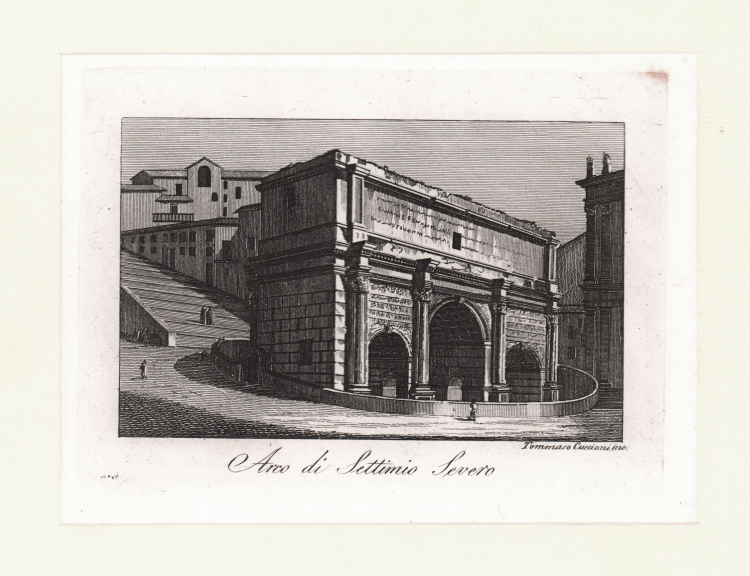



| Reference: | S31715 |
| Author | Tommaso CUCCIONI |
| Year: | 1830 ca. |
| Zone: | Settimio Severo |
| Measures: | 135 x 95 mm |


| Reference: | S31715 |
| Author | Tommaso CUCCIONI |
| Year: | 1830 ca. |
| Zone: | Settimio Severo |
| Measures: | 135 x 95 mm |
View taken from the Nuova raccolta delle principali vedute antiche e moderne dell’alma citta di Roma e sue vicinanze. Incise a bullino da Achille e Pietro Parboni, engraved by Achille and Pietro Parboni printed in Rome, by Giacomo Antonelli, s.d. [1824-29].
This is a collection in 8° oblong, containing 100 views engraved in copper by Achille and Pietro Parboni - as indicated on the title page - dedicated to the most beautiful views of Rome and its surroundings. Undated, but circa 1830 as all the engravings are dated between 1824 and 1829. As often happens in similar collections, there are also engravings by other artists such as Pietro Ruga, Francesco Rinaldi, Tommaso Cuccioni, Giovanni Acquaroni and Gaetano Cottafavi.
Tommaso Cuccioni is one of the first and most renowned Roman photographers of the nineteenth century whose date of death (1864), but not his date of birth. His initial activity, however, was that of engraver and chalcographer, devoting himself to the trade of prints, with a store first in Via della Croce, n. 88, and then in Via Condotti, n. 18, as can be seen from the repertoires of the time of Gregory XVI who indicate him as a dealer of prints, paintings and fine art objects. In the Forties, together with the sale of chalcographic prints, he also began the sale of daguerreotypes and calotypes that he did not yet execute personally, but he commissioned to other Roman professionals of the origins and especially to G. Caneva, his great friend. Only after 1851, that is after the finalization of the wet collodion process, Cuccioni began his new and very lucky career as a photographer because only then, and not before, photography really set itself as an alternative means - with respect to the other reproductive techniques of the past - in the field of image production and reproduction.
Etching, in good condition.
Tommaso CUCCIONI (Roma, 1790 circa – 23 agosto 1864)
|
He is one of the first and most renowned Roman photographers of the nineteenth century whose date of death (1864), but not his date of birth. His initial activity, however, was that of engraver and chalcographer, devoting himself to the trade of prints, with a store first in Via della Croce, n. 88, and then in Via Condotti, n. 18, as can be seen from the repertoires of the time of Gregory XVI who indicate him as a dealer of prints, paintings and fine art objects. In the Forties, together with the sale of chalcographic prints, he also began the sale of daguerreotypes and calotypes that he did not yet execute personally, but he commissioned to other Roman professionals of the origins and especially to G. Caneva, his great friend. Only after 1851, that is after the finalization of the wet collodion process, Cuccioni began his new and very lucky career as a photographer because only then, and not before, photography really set itself as an alternative means - with respect to the other reproductive techniques of the past - in the field of image production and reproduction.
Translated with www.DeepL.com/Translator (free version)
|
Tommaso CUCCIONI (Roma, 1790 circa – 23 agosto 1864)
|
He is one of the first and most renowned Roman photographers of the nineteenth century whose date of death (1864), but not his date of birth. His initial activity, however, was that of engraver and chalcographer, devoting himself to the trade of prints, with a store first in Via della Croce, n. 88, and then in Via Condotti, n. 18, as can be seen from the repertoires of the time of Gregory XVI who indicate him as a dealer of prints, paintings and fine art objects. In the Forties, together with the sale of chalcographic prints, he also began the sale of daguerreotypes and calotypes that he did not yet execute personally, but he commissioned to other Roman professionals of the origins and especially to G. Caneva, his great friend. Only after 1851, that is after the finalization of the wet collodion process, Cuccioni began his new and very lucky career as a photographer because only then, and not before, photography really set itself as an alternative means - with respect to the other reproductive techniques of the past - in the field of image production and reproduction.
Translated with www.DeepL.com/Translator (free version)
|